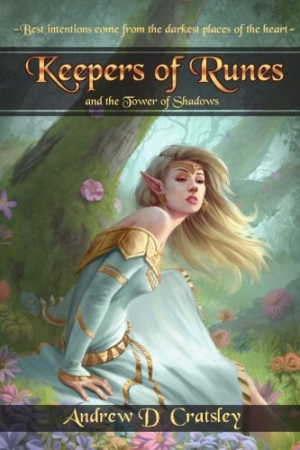
Keepers of Runes and the Tower of Shadows
As the action-filled plot progresses, secrets of the characters’ rich, mysterious histories are revealed.
Imagine a quest fraught with peril, elves working with dwarfs and human mercenaries to overcome a dark force, frequent weapon and armor upgrades, potions and spells, and a story held together by magic-infused melees. This description could fit a number of fantasy books, movies, and role-playing games, and it works for Andrew D. Cratsley’s Keepers of Runes and the Tower of Shadows as well. It has all the color, imagination, and drama one might expect from the genre, as well as complexity and emotional depth.
An unlikely band of heroes stumbles onto the evil workings of the dark elf necromancer, Mortiscet, and uncovers a sinister plot that threatens the world of Terranesit. Corinth, a recently promoted but untried elf-knight, must overcome his past and prejudices and learn to trust his companions: fiery Nadine, a hard-drinking, soft-hearted pickpocket turned mercenary; Aventis, a human ranger specializing in long swords and bows; and Rieka, a half-elf of questionable power and loyalties.
The combat scenes are well written, integrating creative opponents, defensive and offensive use of traditional weapons and magic spells, and unique stages for fighting. One day the gang is fending off massive glacial wolves from the frozen forest of Icefall Cove, and another, battling the deadly scorva, the humanlike scorpions found in the Great Desert of the south. The colorful scenery and constant traveling begs for a map, which is conspicuously absent here. The action drives the plot, interspersed with insightful glimpses into the mysterious, secret pasts of Aventis, Nadine, Rieka, and particularly Corinth. Be forewarned, though: much like The Hobbit: The Desolation of Smaug, the culmination of events builds up the expectation of a grand finale, but it stops abruptly with a cliffhanger ending. Luckily, Cratsley has promised a sequel, Keepers of Runes and the Rise of Khalid.
Corinth, at 120 years old, is still young for an elf, and it shows. There is copious smirking, snickering, and eye-rolling from all four fighters, as well as “giggling” from the women, who are consistently referred to as “the girls,” as in, “When the captain stormed off, the girls exploded into fits of giggles.” There is some light flirtation between Aventis and Nadine, and a definite attraction between Corinth and Rieka, which spices up the time between attacks. The level of maturity is questionable, though, and almost every encounter involves someone’s face turning scarlet with embarrassment and even includes a few tearful, emotional outbursts, none of which seems entirely appropriate for hardened mercenaries and warriors. All of this suggests that Keepers of Runes and the Tower of Shadows may be better suited for an audience of teenagers or young adults who can relate to and appreciate such youthful, reckless behavior and naive logic.
Young fantasy fans or anyone new to the genre will want to explore Keepers of Runes and the Tower of Shadows. In particular, the fast pace and gaming-style characteristics may appeal to more reluctant readers and inspire future fantasy enthusiasts.
Reviewed by
Pallas Gates McCorquodale
Disclosure: This article is not an endorsement, but a review. The publisher of this book provided free copies of the book and paid a small fee to have their book reviewed by a professional reviewer. Foreword Reviews and Clarion Reviews make no guarantee that the publisher will receive a positive review. Foreword Magazine, Inc. is disclosing this in accordance with the Federal Trade Commission’s 16 CFR, Part 255.
